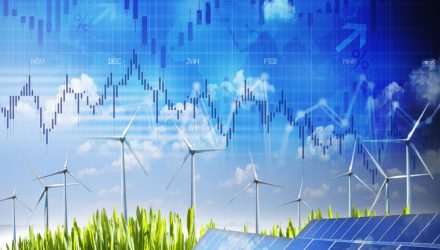Seismic shifts pertaining to energy consumption with data confirming a renewables boom is underway. That theme is one of the bedrocks for ETFs, such as the ALPS Clean Energy ETF (ACES).
ACES follows the CIBC Atlas Clean Energy Index. That benchmark is comprised of U.S. and Canada-based companies that primarily operate in the clean energy sector. Constituents are companies focused on renewables and other clean technologies that enable the evolution of a more sustainable energy sector.
Data confirm that domestic utilities are generating less power via coal and more with alternative energy sources, such as wind and solar, potentially representing a long-term boon for ACES and its components. Other data points indicate coal is dying a slow death.
“Coal consumption will be crushed in 2020,” according to Moody’s Investors Service. “We expect a sharp and sustained slowdown in economic activity will result in lower economic growth, reduced demand for electricity and reduced demand for steel.”
Dealing Some ACES
ACES’ components provide the products and services that enable the evolution of a more sustainable energy sector. The green energy companies are engaged in renewable energy sources, including solar power, wind power, hydroelectricity, geothermal energy, biomass, biofuels, and tidal/wave energy; clean technologies, including electric vehicles, energy storage, lithium, fuel cell, LED, smart grid, and energy efficiency technologies; and other emerging clean energy activities and technologies.
Indeed, ACES is in the right place at the right time.
“The U.S. consumed more energy from renewable sources last year than from coal, the first time that’s happened since the late 1800s when wood stopped powering steamships and trains,” reports Bloomberg. “Coal accounted for 11.3 quadrillion British thermal units of energy in 2019, a 15% decline from the prior year, a drop driven mainly by utilities turning away from the dirtiest fossil fuel.”
Currently, coal and renewables account for roughly the same percentage of power consumption in the U.S., but the latter is poised to overtake the former, particularly as renewable costs decline. In fact, it’s likely that by 2030, new solar and wind farms will cost less than coal-fired plants. Photovoltaic costs plunged 82% over the prior decade, indicating it’s reasonable to expect solar will eventually be more cost-efficient than coal.
Other alternative energy ETFs include the First Trust Global Wind Energy ETF (FAN) and the SPDR Kensho Clean Power ETF (CNRG).
For more on cornerstone strategies, visit our ETF Building Blocks Channel.
The opinions and forecasts expressed herein are solely those of Tom Lydon, and may not actually come to pass. Information on this site should not be used or construed as an offer to sell, a solicitation of an offer to buy, or a recommendation for any product.








